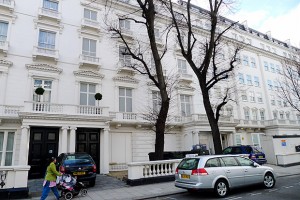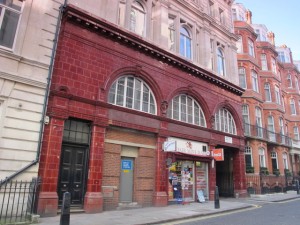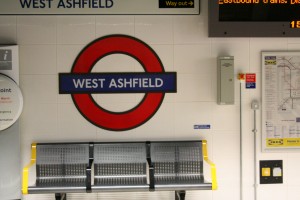For any Londoner, the tube is a godsend that gets you from point A to point B. The thirteen colour-coded lines intertwine like an electrical diagram, and are the most efficient manner of transport across the city as you head across the river and to the four furthest ends on the giant mechanical snakes that tunnel under and over the city’s networks. But for those who have read Neil Gaiman’s Neverwhere or China Miéville’s UnLunDun, we know that the Underground network holds a plethora of secrets from the commuters. Who are the Seven Sisters on the Victoria Line? Is there really a secret underground tube station for members of the Royal Family? We all know that some stations are temporarily closed for upgrade works or maintenance – but are there some that still exist which have experienced a more permanent closure? What are the London Underground secrets?
Fake buildings
 The beautiful frontage of these townhouses in Leinster Gardens look like all the other houses on the Paddington street. But peek behind the facade and you’ll find that two of the houses don’t really exist! Displaying the same five-storey facade as their neighbours, right down to the columns and decorations, you’d be forgiven for thinking numbers 23 and 24 to be real apartments. Only the eighteen blackened windows are a giveaway, at least until you walk around back.
The beautiful frontage of these townhouses in Leinster Gardens look like all the other houses on the Paddington street. But peek behind the facade and you’ll find that two of the houses don’t really exist! Displaying the same five-storey facade as their neighbours, right down to the columns and decorations, you’d be forgiven for thinking numbers 23 and 24 to be real apartments. Only the eighteen blackened windows are a giveaway, at least until you walk around back.
There you’ll find a gaping space where the original houses once stood, replaced by railway tracks. The extension of the Metropolitan Railway between Paddington and Bayswater in 1868 necessitated the demolition of this unfortunate pair, but local government decided to keep the street’s facade rather than have a glaring gap for all to see.
The levelled area behind the facade came to serve another purpose too. Exposed to the elements, trains travelling underground could effectively come up for air at this spot to “vent off” dispersing fumes into the atmosphere rather than leaving them to build up in the tunnels.
Ghost stations
To discover another strange secret, simply look through the window as you travel between Tottenham Court Road and Holborn on the Central Line. You may be able to catch a glimpse of an abandoned station which used to be the British Museum platform. If you get a chill at the sight, that’s probably because no passenger has alighted at this ghostly spot since 1932!
 If you’re particularly observant you might even notice the tunnel walls on the underground. Sometimes they’re bricks, sometimes they’re cast-iron tubing. Sometimes they’re not there at all. Pay close attention on the Piccadilly Line as you travel between Green Park and Hyde Park Corner and look for the bricked up section. This used to be a station named Down Street, closed in the same year as the abandoned British Museum platform. Often referred to as ghost stations, these are just two of around 40 abandoned or relocated stations dotting the network’s entire 255 miles of trackway. Though many have vanished, leaving only a trace of their existence, others are still intact; dusty time capsules of days long past.
If you’re particularly observant you might even notice the tunnel walls on the underground. Sometimes they’re bricks, sometimes they’re cast-iron tubing. Sometimes they’re not there at all. Pay close attention on the Piccadilly Line as you travel between Green Park and Hyde Park Corner and look for the bricked up section. This used to be a station named Down Street, closed in the same year as the abandoned British Museum platform. Often referred to as ghost stations, these are just two of around 40 abandoned or relocated stations dotting the network’s entire 255 miles of trackway. Though many have vanished, leaving only a trace of their existence, others are still intact; dusty time capsules of days long past.
Ancient masonry
While we’re on the topic of time capsules, several historic pieces of masonry can be found along the London network.
A small section of Roman-built wall still survives in the trackside walls of Tower Hill station, near platform level, and one of the largest fragments of the London Wall also stands just outside this place. Definitely built to last, these walls remained in active use for over 1,000 years after the conquerors erected them. During the Second World War, they even survived the devastation of the German Blitz.
In fact, many Tube stations preserve their own bit of history in a unique way. Though recently refurbished, Bounds Green conserved the Holden-style historical features of its architecture, awarded a Grade II listed status by English Heritage. Visitors to the Finsbury Park station may notice murals showing a pair of duelling pistols: a reminder of the days when gentlemen would visit the park after hours to defend their honour!
Hauntings
London’s tube network doesn’t only boast ghost stations but according to some, actual spectres.
One William Terris met an untimely end near the Covent Garden line in 1897 and has reportedly been wandering the tracks ever since. Witnesses say one can see him creeping around the tunnels and platforms of Covent Garden, recognizable by his distinctive appearance: a frock coat, tall hat and gloves.
Old William isn’t the only ghoul haunting the lines though. Visitors to Farringdon station should try remaining dead silent. Apparently if one keeps quiet for long enough, the cries of the “Screaming Spectre” become audible. Believe to have been a milliner, this spirit never shows itself, but its cries are reportedly enough to chill the blood.
Who are the seven sisters?
Commuters may have heard this somewhat ominous name before, but the area now known as “Seven Sisters” was once called Page Green.
The spot takes its iconic name from seven elms which were planted in a circle with a walnut tree at their centre. It didn’t take long for the locals to catch on, with Page Green adopting its new moniker by 1732. The trees were later replanted further to the east in 1876, and now lie on Ermine Street (the Roman road connecting London to York) and very close to an underground tube station.
No gathering of ghouls but simply a cluster of trees, the Seven Sisters nonetheless have a dire note to their history. A local vicar and historian William Bedwell remarked upon the sisters and the Walnut at their centre in his work Brief Description of Tottenham. He described the Walnut as an “arboreal wonder” but noted that the central tree was popularly associated with the burning of an unknown Protestant…
A make-believe tube station
 From ghost stations to a platform that will never see service, but shines as though brand new: we have the West Ashfield tube station.
From ghost stations to a platform that will never see service, but shines as though brand new: we have the West Ashfield tube station.
Located on the 3rd floor of an office block in West Kensington, this is a fully-fitted fake tube station, right down to display boards and Oyster card readers. Visitors will have the surreal experience of entering a generic office building only to find on the third floor an entrance to a tube station, complete with fake newspaper stall!
The whole floor is in fact used for training staff and is incredibly realistic. Though no train actually pulls up at the platform, great care was taken to simulate the arrival of one. The platform rumbles, speakers blare and drown out conversation and a corner-mounted fan blows to remind one of the rushing winds which herald a train’s appearance.
Holloway road spiral escalator
The Piccadilly Line plays host to another of history’s discarded projects: the spiral escalator. An interesting experiment with platform-to-surface transportation, the line’s second lift shaft at Holloway Road was fitted with an untried spiral escalator, constructed by the Reno Company of America.
Exactly what it sounds like, this escalator ran around the shaft’s circumference, with separate spirals for going up and down. Not much else is known about this strange escalator except that it proved to be a spectacular failure, used only for a day or so and never opened to the general public. Almost completely removed shortly after its installation, there are still traces to be seen. In fact, a few years ago a small section of the escalator was recovered in the sump of the lift shaft and is now preserved in London’s Transport Museum.
To this day, carefully looking through the grille that covers the entrance to the second lift shaft, one can see the spot where the escalator used to be, as well as a more modern (and more practical) metal staircase that was fitted instead.
Royal tubes and underground cities?
A strange rumour persists about Buckingham Palace, claiming that beneath the stately home lies a tube station reserved for the Royal Family. The rumour goes that this personal tube network goes all the way up to the royal residences in Scotland, the idea being that in the event of war, the Queen and her family could escape from London.
A great urban myth down to its embellishments, the rumour also claims that Prince Andrew once tried to use the tube, but was banned from doing so. Apparently the Queen wanted it kept top secret for fear of public reaction to the thought of being abandoned during times of crisis!
Another intriguing part of the story mentions ‘Q-Whitehall’: an underground town to house the nation’s finest, from which they could govern in the event of a national attack. Rumoured to have been built in the 1990’s at the cost of £110 million, there are supposedly entrance points to Q-Whitehall around the city, disguised as shops, houses and even phone boxes!
A bunker beneath the city
There’s some truth to such rumours though, as an article published in 2008 on Economist.com made clear. Their correspondent in Britain was granted access to an abandoned building on 39 Furnival Street, where he was given a tour of the Kingsway tunnels: a now abandoned M-16 bunker.
An underground city in miniature, the Kingsway tunnels were dug in 1940 as London came under attack by German bombers. Originally designed as an air shelter capable of housing up to 8,000 people, the site was ultimately used by the “Inter Services Research Bureau”, a front for the research and development arm of M-16. Though possibly a bit claustrophobic, the tunnels were far from uncomfortable in their design. A restaurant, licensed bar and games room were all available, with mirrored walls and fake windows added to the decoration to make the space seem less cramped.
Though once subject to the Official Secrets Act, the property is ironically now up for sale! After being sold to the Post Office after the war and later passed to British Telecom, the warren is currently going for a cool 5 million.
With secrets like these hiding amidst the city facade one has to wonder, what else is there just waiting to be found?